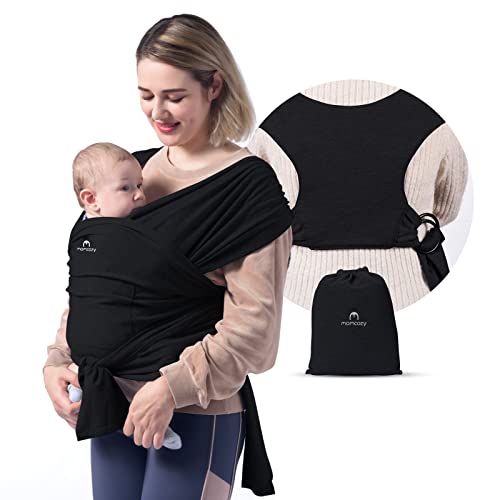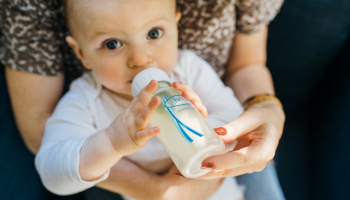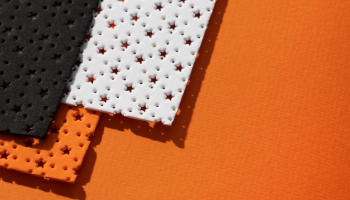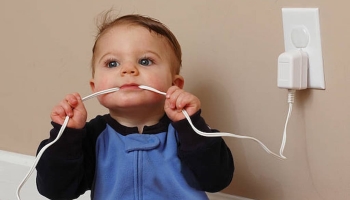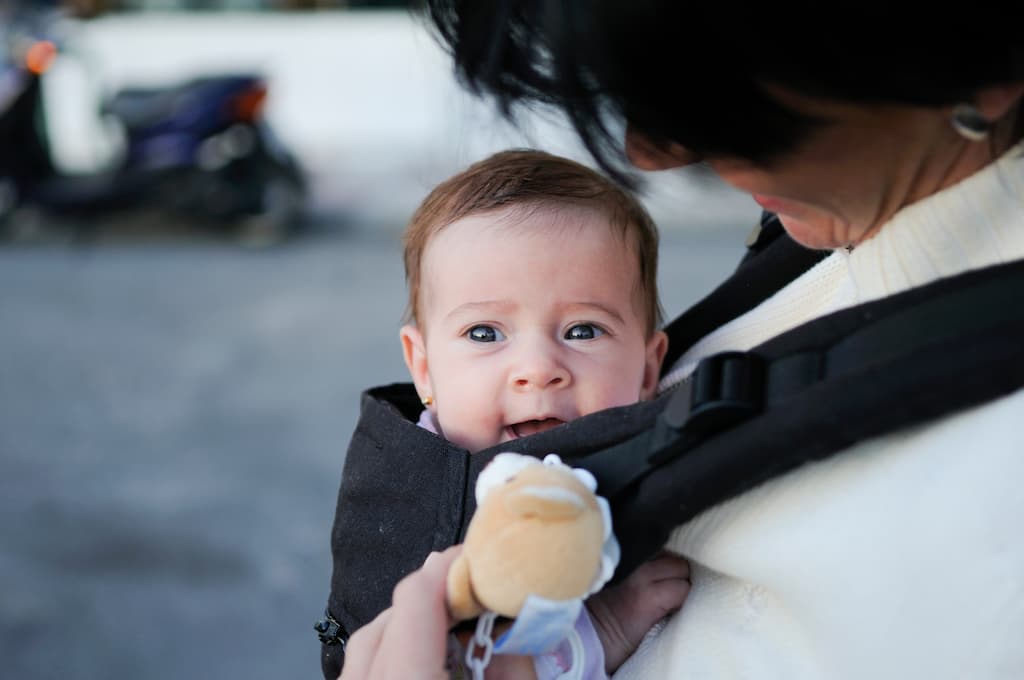
Choosing a baby carrier as a convenient way to carry your child is a smart thing to do if it is something you plan to use. The best baby carriers are ergonomic for the carers, suited to different body types, easy to use, wash, and comfortable for you and your child. It is also suitable for calming a fussy baby.
After testing top models, the best overall baby wrap is the Momcozy Baby Wrap Carrier Sling because it is comfortable, easy to put on, and very close fitting. It can be used long-term, supporting up to 50 pounds. It acts as a privacy shield for breastfeeding moms.
Top 5 Baby Carriers on the Market
Description
This 4-in-1 convertible is a unisex baby carrier. It weighs 15.1 ounces and is 10.2 x 10.2 x 4.3 inches in size. This carrier has a facing-in and facing-out design for newborns and older babies between 8 and 32 pounds. The wearer can adjust the ergonomic 2-position seat, padded shoulder straps, and supportive waist belt for a more comfortable fit. These features are designed to fit various body types and lifestyles. The wearer can bond with the baby and experience hands-free convenience around the house or outside. You can machine wash this baby carrier. It is also good to put your baby to sleep, especially if it likes skin contact. This is one of the best baby carriers because it has the best value.
Features
- 4 carry positions: facing-in (narrow seat), facing-in (wide seat), facing-out, and back.
- Adjustable harness.
- Soft and lightweight.
- Safe and durable.
- Ease of use.
- Padded straps.
Pros
- Easy to use.
- Good cost.
- Soft and comfortable.
- Safe.
- Fits a wide range of body sizes.
- Padded straps.
Cons
- It could have better back support.
- The straps and buckles may be intimidating at first.
Description
The KeaBabies wrap carrier is an ergonomically designed soft structured carrier made with soft, breathable, and stretchy long piece of fabric for a secure fit. It is easy to wear with no need for constant readjustment. It weighs 1.1 pounds and is 204.72 x 21.65 x 0.39 inches. It is for babies between 7 pounds and 35 pounds. This is one of the best baby wraps because it evenly distributes your baby’s weight for optimal back and shoulder support.
This baby carrier is certified by the International Hip Dysplasia Institute (IHDI) to promote the baby’s healthy hip development. This baby wrap helps you bond with your baby while staying hands-free. Stretchy wraps create a cozy environment that mimics the womb to make your baby feel calm and secure. This baby sling carrier fits all shapes and sizes. It is versatile and sustainable and can be used as a pregnancy support band, postpartum wrap, or nursing cover.
Features
- Cotton and Proprietary fabric tech.
- A long piece of fabric that can go around your body.
- You can carry a baby in the front and back.
- Machine wash cold, air dry, or tumble dry low; wash before first use.
- One size fits all.
Pros
- Carries baby securely.
- Easy to use and comfortable to wear.
- Easy to clean.
- It is firm and secure, not too stretchy that your baby sags or falls to the side.
- Good back support.
Cons
- It’s not breathable enough for hot days.
- You may need to watch a video instead of reading directions to be able to use it properly.
Description
The Momcozy baby wrap carrier allows babies to sit astride and help babies develop healthy hip bones and spine from 0-1 year old. This is the best baby wrap as it provides greater comfort for both the baby and the mother by distributing the baby’s weight evenly, reducing pain and pressure in the upper back, shoulders, neck, or waist. This is the easiest baby wrap because you don’t have to wrap; the baby wrap can be adjusted to any size with the O ring. The stretchy fabric covers from XXS – XXL; it adapts to you and your baby’s body shape and is suitable for the whole family use.
The baby wrap carrier fabric is made of 95% polyester and 5% spandex material, comfortable and breathable, soft-structured, and skin-friendly. It is easier to wear, fosters a close parent-child relationship, and enhances your baby’s sense of security. This baby wrap is the easiest baby carrier because you have to put it on like a t-shirt; it even acts as a privacy shield for breastfeeding moms as you can breastfeed without removing your baby from the baby carrier. It weighs 1.37 pounds and is 9.8 x 7.91 x 2.8 inches. It carries babies from 7 to 50 pounds.
Features
- Machine wash.
- Ease of use.
- Adjustable size.
- High-quality fabric.
- Breathable & soft structured piece of fabric.
- You can carry the baby facing in or facing out.
Pros
- Convenient and comfortable to wear.
- Easy to clean.
- Easy to use.
Con
- It may not be suitable for sweltering days.
Description
The LÍLLÉbaby Complete All Seasons baby carrier is the best as it features six ergonomic carry positions for 360-degree babywearing. There is a zip-down in front that reveals a breathable mesh, allowing you to control your baby’s temperature. This baby carrier is comfortable to wear and has a functional style.
This baby carrier has adjustable side panels that widen and narrow the seat for comfortable hip positioning. It allows for closeness and independence in balance. The baby carrier provides comfort and support for all with two-way straps for front or backpack-style carrying, a large storage pocket, a removable sleeping hood, and an extendable torso. It weighs 1.1 pounds and is 14 x 4 x 11 inches. It carries babies from 7 to 45 pounds. The fabric is made out of polyester and cotton.
Features
- Machine wash.
- Detachable sun hood.
- Six ways to wear (0 – 3m front fetal, 0 – 12m infant inward(narrow seat), 6 – 18m ergonomic outward, 6m+ toddler inward(wide seat), 6m+ hip carry, 6m+ back carry).
- Newborn through toddler.
- Widen seat as baby grows.
- Thick padding.
- Lumbar support.
Pros
- Adjustable size.
- Easy to use.
- Comfortable to wear.
- Lumbar support.
- Breathable.
Con
- It may not be suitable for short parents.
Description
This baby carrier is comfortable, ergonomic, and compact. It includes a hip pouch, and it’s all you need for on-the-go baby-wearing. It weighs 1.08 pounds and is 12.2 x 12.2 x 16.5 inches. It carries babies from 7 to 45 pounds. It is efficiently designed for babies 12-30 pounds, four months to 2 years.
Features
- Lightweight.
- Detachable hood.
- Large waistband hip pouch.
- Soft mesh padding (leg, waistband & shoulder straps).
Pros
- Integrated carrier pouch.
- Easy to use.
- Comfortable for baby-wearing.
Cons
- Straps aren’t padded.
- It’s a soft, light material but not a soft, structured carrier.
- Not suitable for short parents.
Buying Guide
When looking for a suitable, comfortable, and best baby wrap carrier, you must consider certain things. How old is your child? What is the weight of your baby? If your child is over six months old, you may not want to buy a wrap; a carrier will be better. Younger babies are more suited for baby wraps.
What do you want to use it for? If your baby is clingy or needy, you may want to buy something very comfortable, breathable, and durable. If your baby needs skin-to-skin contact or fostering bonding, you may need a baby wrap if they are under six months. If you use it to run errands and get things done or occasionally, you may want something not too expensive but sturdy.
Who will be using it? You may want a baby carrier that is adjustable if your baby has more than one carer. How much are you willing to spend? Many things go into deciding the baby wrap carrier you want to buy.
Adjustable and fit
The best baby wrap carriers come in a range of positions that help your baby to optimal comfort as they grows. You can wear your baby facing forward from when they can hold their neck up well, and they’re big enough, usually from four to ten months old. You also have to consider your size as a parent; some baby carriers are unsuitable for plus-size or short parents. Younger babies can’t hold their head and neck up; it is essential to choose a baby carrier that can support their head and neck when facing inwards. You should also consider a baby carrier that is comfortable for your back and shoulder.
Support
The best baby wrap carrier should give you the best support. When you decide on the sling or carrier you’d like to use for your baby, you should check that it provides you and your baby with the support you require. It should also be comfortable for others wearing it besides yourself. When choosing your baby carrier, it may state that it’s suitable for newborns, but every baby is born at a different weight, so check your baby meets the minimum weight requirement.
If you plan to use a baby carrier for your newborn, you may realize it is designed to support their back, head, and developing hips and spine. If you’re getting a baby carrier for your older baby, then they should be able to sit upright with their air passages clear. The best baby wraps are ergonomic and provide the best support for the wearer’s back. Some soft structured carriers come with extra lumbar support. You should also consider proper fits if you are plus-size or short.
Your baby should be held in the frog-leg position in the baby wrap carrier, and their knees should be level with or higher than their hips to ensure they’re comfortable. Your baby’s back should be supported in the natural curved ‘C-shape’ and snug enough to support your baby adequately.
Ease of use
It is best to buy a baby carrier that is easy to use. Choose a baby wrap that can wrap the baby easily or a baby carrier that doesn’t require an elaborate setup.
Material and care
Except you use your baby carrier occasionally, you will probably use it for several hours a day, several days per week. It is essential to buy a baby wrap carrier that has breathable fabric and will not be too hot for you and the baby. Your baby carrier will also get dirty from sweat, drool, spit up, poop, biting, and vomit; it will need you to clean it as often as it needs, so buy a baby carrier you can quickly and adequately care for. If you don’t like hand washing, check for one you can wash in the washing machine.
Safety
Wearing your baby is one of the best ways to bond with your baby and keep your baby calm and close to you. When using a baby carrier, make sure it’s:
- Tight.
- In view at all times.
- Close enough to kiss.
- Keep your chin off the chest.
- Supported back.
Use your baby carrier as directed, and make sure all buckles and knots are fastened securely. Always make sure you can see your baby’s face. If you are using the hip carry position, your baby’s thighs should be flexed, supported, and spread apart. The M-position is recommended when wearing your baby in a hip carry position. Do not carry your baby facing outwards before they are old enough for that.
How did we select these carriers
These baby carriers and baby wraps have been chosen by our team and tested by other parents with children of different sizes as stated by the carrier’s standard weight. We have selected the best baby wraps through several hours of tests. We have also consulted baby-wearing experts. We understand the concern a parent has when choosing the best baby carrier for front carriers, wrap carriers, and hip carry. We have considered the needs of parents and why they use these baby carriers. We have compared comfort(the baby and the parent), versatility in carry positions and baby’s age, and quality of fabric and design.
Frequently Asked Questions
Are baby carriers better than baby wraps?
Baby carriers are not better than baby wraps; they serve different purposes. However, you can use a baby carrier longer than a baby wrap.
A baby wrap is the best support for newborns and premature babies. Being baby-wrapped, skin-to-skin, makes a baby feel safe and secure, as if in the womb. This kind of contact helps your baby grow up to be confident and independent. As your child becomes more active and grows, you may want to change to a structured carrier.
An ergonomic, soft-structured carrier allows you to carry your child on your front or back. It offers support with shoulder straps and buckles that are easy to put on. A structured carrier provides more comfort for your baby as they grow older, allowing them to move their legs, arms, and head more freely. Some carriers come with an infant insert and may be comfortable for newborns.
Structured carriers can carry a baby up to 40 pounds; baby wraps are better when you weigh less than 20 pounds.
Baby carriers are easier to use and wear, and a baby wrap may require trying different tying techniques and maybe even watching instructional videos.
What is the best and safest baby carrier?
When you use your baby carrier the right way, carriers are safe. Do not use a carrier that is too tight on your baby’s legs to avoid the risk of hip dysplasia.
How long can a newborn be in a wrap carrier?
Carrying your baby upright can help engage their head, neck, stomach, and back muscles. Wearing your baby improves bonding, helps them sleep, soothes them, regulates their temperature, aids lactation, advances their communication skills, and promotes cognitive and social development. There is no set time limit for how long you should carry your baby in a wrap carrier as long as you’re both happy and comfortable.
As they grow older, babies need time to move freely, develop their muscles, and learn new skills. They will be happy spending more time playing on the floor. At this stage, you should let your baby know skills like rolling, crawling, sitting, and walking.
Babywearing will not make your child clingy. Secure attachment is suitable for your baby’s development.
Last update on 2025-03-31 / Affiliate links / Images from Amazon Product Advertising API



